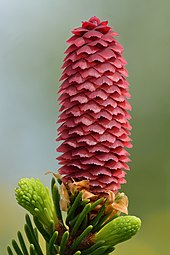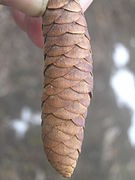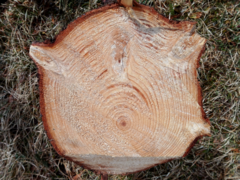Picea abies
| Norway spruce | |
|---|---|

| |
| Scientific classification | |
| Kingdom: | Plantae |
| Clade: | Tracheophytes |
| Clade: | Gymnospermae |
| Division: | Pinophyta |
| Class: | Pinopsida |
| Order: | Pinales |
| Family: | Pinaceae |
| Genus: | Picea |
| Species: | P. abies
|
| Binomial name | |
| Picea abies | |

| |
| The Norway spruce range.[1] | |

| |
| Distribution map. Green: native range. Orange: introduced areas. Crosses and triangles denote isolated populations. | |
Picea abies, the Norway spruce[2] or European spruce,[3] is a species of spruce native to Northern, Central and Eastern Europe.[4]
It has
Description


Norway spruce is a large, fast-growing
Range and ecology
The Norway spruce grows throughout Europe from Norway in the northwest and Poland eastward, and also in the mountains of central Europe, southwest to the western end of the Alps, and southeast in the Carpathians and Balkans to the extreme north of Greece. The northern limit is in the arctic, just north of
Norway spruce cone scales are used as food by the
.Taxonomy
Populations in southeast Europe tend to have on average longer cones with more pointed scales; these are sometimes distinguished as Picea abies var. acuminata, but there is extensive overlap in variation with trees from other parts of the range.[8][9][10]
Some botanists treat
Another spruce with smoothly rounded cone scales and hairy shoots occurs rarely in the Central Alps in eastern
Cultivation
The Norway spruce is one of the most widely planted spruces, both in and outside of its native range, and one of the most economically important coniferous species in Europe.[3] It is used as an ornamental tree in parks and gardens. It is also widely planted for use as a Christmas tree. Every Christmas, the Norwegian capital city, Oslo, provides the cities of London (the Trafalgar Square Christmas tree), Edinburgh and Washington, D.C., with a Norway spruce, which is placed at the central most square of each city. This is mainly a sign of gratitude for the aid these countries gave during the Second World War.[13] In North America, Norway spruce is widely planted, specifically in the
Seed production begins when the tree is in its fourth decade and total lifespan is up to 300 years in its natural range in Europe. Introduced Norway spruces in the British Isles and North America have a much shorter life expectancy. As the tree ages, its crown thins out and lower branches die off.
In the northern US and Canada, Norway spruce is reported as invasive in some locations; however, it does not pose a problem in Zone 6 and up as the seeds have a significantly reduced germination rate in areas with hot, humid summers.
The Norway spruce tolerates acidic soils well, but does not do well on dry or deficient soils. From 1928 until the 1960s it was planted on surface mine spoils in Indiana.[3]
Cultivars
Several
- 'Acrocona'[17] – 4 m (13 ft) tall and broad
- 'Clanbrassiliana'[18] – 1.2 m (3.9 ft) tall by 2.4 m (7.9 ft) broad
- 'Inversa'[19] – 9 m (30 ft) tall by 4 m (13 ft) broad
- 'Little Gem'[20] – 0.5 m (1.6 ft) tall and broad
- 'Nidiformis'[21] – 1.5 m (4.9 ft) tall by 4 m (13 ft) broad
-
Picea abies 'Inversa'
-
Picea abies 'Little Gem'
-
Picea abies 'Aleksandra Fastigiata'
-
Picea abies 'Acrocona' 02
-
Picea abies 'Virgata'
Uses
The Norway spruce is used in
production.-
Picea abies trunk cross section
-
Picea abies trunk cross section close-up
The Norwegian company Borregaard produces the synthetic substitute for natural vanilla Vanillin using the Norwegian spruce.[23] They are currently the only company to produce wood based vanillin and is claimed by the company to be preferred by their customers due to, among other reasons, its much lower carbon footprint than petrochemically synthesized vanillin.[24]
It is esteemed as a source of tonewood by stringed-instrument makers.[25] One form of the tree called Haselfichte (Hazel-spruce) grows in the European Alps and has been recognized by UNESCO as intangible cultural heritage. This form was used by Stradivarius for instruments.[26]
As food
The tree is the source of spruce beer, which was once used to prevent and even cure scurvy.[27]
Norway spruce shoot tips have been used in traditional Austrian medicine internally (as syrup or tea) and externally (as baths, for inhalation, as ointments, as resin application or as tea) for treatment of disorders of the respiratory tract, skin, locomotor system, gastrointestinal tract and infections.[28]
During the production of
Longevity
A press release from Umeå University says that a Norway spruce clone named Old Tjikko, carbon dated as 9,550 years old, is the "oldest living tree".[30] The oldest individual specimen of Norway spruce discovered by tree ring dating found in 2012 in a nature reserve of Buskerud County, Norway, was found to be 532 years old.[31]
However,
The stress is on the difference between the singular "oldest tree" and the multiple "oldest trees", and between "oldest clone" and "oldest non-clone". Old Tjikko is one of a series of genetically identical clones growing from a root system, one part of which is estimated to be 9,550 years old based on carbon dating. The oldest known individual tree (that has not taken advantage of
Genetics
The genome of Picea abies was sequenced in 2013, the first gymnosperm genome to be completely sequenced.
Within populations of Picea abies there is great genetic variability, which most likely reflect populations' isolation in glacial refugia and post-glacial evolutionary history. Genetic diversity can in particular be detected when looking at how the populations respond to climatic conditions. E.g. variations in timing and length of the annual growth period as well as differences in frost-hardiness in spring and autumn. These annual growth patterns are important to recognize in order to choose the proper reforestation material of Picea abies.[38]
Chemistry
Research
Synonyms
Picea abies (L.) H. Karst is the accepted name of this species. More than 150 synonyms of Picea abies have been published.[43]
- Pinus abies L.
- Abies picea Mill.
- Pinus pyramidalis Salisb.
- Pinus abies subsp. vulgaris Voss
- Abies abies (L.) Druce
Some
- Abies alpestris Brügger
- Abies carpatica (Loudon) Ravenscr.
- Abies cinerea Borkh.
- Abies clambrasiliana Lavallée
- Abies clanbrassiliana P. Lawson
- Abies coerulescens K. Koch
- Abies conica Lavallée
- Abies elegans Sm. ex J.Knight
- Abies eremita K.Koch
- Abies erythrocarpa (Purk.) Nyman
- Abies excelsa (Lam.) Poir.
- Abies extrema Th.Fr.
- Abies finedonensis Gordon
- Abies gigantea Sm. ex Carrière
- Abies gregoryana H. Low. ex Gordon
- Abies inverta R. Sm. ex Gordon
- Abies lemoniana Booth ex Gordon
- Abies medioxima C.Lawson
- Abies minuta Poir.
- Abies montana Nyman
- Abies parvula Knight
- Abies subarctica (Schur) Nyman
- Abies viminalis Wahlenb.
- Picea alpestris (Brügger) Stein
- Picea cranstonii Beissn.
- Picea elegantissima Beissn.
- Picea excelsa (Lam.) Link
- Picea finedonensis Beissn.
- Picea gregoryana Beissn.
- Picea integrisquamis (Carrière) Chiov.
- Picea maxwellii Beissn.
- Picea montana Schur
- Picea remontii Beissn.
- Picea rubra A. Dietr.
- Picea subarctica Schur
- Picea velebitica Simonk. ex Kümmerle
- Picea viminalis (Alstr.) Beissn.
- Picea vulgaris Link
- Pinus excelsa Lam.
- Pinus sativa Lam.
- Pinus viminalis Alstr.
See also
- Pinus resinosa Norway pine
References
- ^ . Retrieved 12 November 2021.
- ^ BSBI List 2007 (xls). Botanical Society of Britain and Ireland. Archived from the original (xls) on 2015-06-26. Retrieved 2014-10-17.
- ^ a b c d Sullivan, Janet (1994). "Picea abies". Fire Effects Information System (FEIS). US Department of Agriculture (USDA), Forest Service (USFS), Rocky Mountain Research Station, Fire Sciences Laboratory. Retrieved 18 November 2009.
- ^ "Picea abies (Norway spruce) description". Conifers.org. Retrieved 2017-01-08.
- ISBN 978-1845337315.
- ISBN 0-00-212035-6
- ^ Taylor, Ronald J. (1993). "Picea abies". In Flora of North America Editorial Committee (ed.). Flora of North America North of Mexico (FNA). Vol. 2. New York and Oxford: Oxford University Press – via eFloras.org, Missouri Botanical Garden, St. Louis, MO & Harvard University Herbaria, Cambridge, MA.
- ^ ISBN 3-87429-298-3.
- ^ ISBN 0-7470-2801-X.
- ^ a b c d e Earle, Christopher J., ed. (2018). "Picea abies". The Gymnosperm Database.
- ^ "Picea abies records". Monumental trees.
- .
- ^ British Embassy Oslo. "Oslo's Christmas tree gift to Trafalgar Square". GOV.UK. Retrieved 28 June 2015.
- ^ "Picea abies - Plant Finder". www.missouribotanicalgarden.org. Retrieved 2024-03-10.
- ^ "ITIS Standard Report Page: Picea excelsa". www.itis.gov. Retrieved 2019-07-10.
- ^ "AGM Plants - Ornamental" (PDF). Royal Horticultural Society. July 2017. p. 78. Retrieved 25 April 2018.
- ^ "RHS Plantfinder - Picea abies 'Acrocona'". Retrieved 25 April 2018.
- ^ "RHS Plantfinder - Picea abies 'Clanbrassiliana'". Retrieved 25 April 2018.
- ^ "RHS Plantfinder - Picea abies 'Inversa'". Retrieved 25 April 2018.
- ^ "RHS Plantfinder - Picea abies 'Little Gem'". Retrieved 25 April 2018.
- ^ "RHS Plantfinder - Picea abies 'Nidiformis'". Retrieved 25 April 2018.
- ^ Buckley, Michael (2005). "A basic guide to softwoods and hardwoods" (PDF). worldhardwoods.com. Archived from the original (PDF) on 19 August 2019. Retrieved 1 October 2017.
- ^ "Sustainable Vanillin from the Forests of Norway". Zanos. 2021-03-31. Retrieved 2024-03-10.
- ^ "Plant-based vanillin". www.borregaard.com. Retrieved 2024-03-10.
- ^ Paul Hostetter. "European spruce ranges, and commentary on Picea spp". Lutherie.net. Retrieved 2017-01-08.
- ^ "Die Haselfichte". Waldwissen.net. 2012-06-20. Archived from the original on 2017-01-19. Retrieved 2017-01-08.
- ^ Karellp (2012-06-11). "New Beer – Spruce Beer". The Black Creek Growler. Retrieved 30 September 2012.
- PMID 23770053.
- ^ "La sangle d'épicéa, secret d'un goût unique". Vacherin Mont-d'Or (in French). Retrieved 11 December 2022.
- ^ "World's oldest living tree discovered in Sweden". Umeå University. April 16, 2008. Archived from the original on 20 April 2008. Retrieved 26 May 2013.
- ^ "The oldest spruce in Northern Europe is 532 years old". 27 October 2012.
- Bryce Canyon National Park Service
- JSTOR 1312652.
- ^ American, Scientific. "Swedish Spruce Is World's Oldest Tree". Scientific American.
- ^ "Old List". Rocky Mountain Tree-Ring Research. Retrieved 16 August 2013.
- PMID 23698360.
- PMID 23698863.
- ^ Skrøppa, T. (2003). "Picea abies - Norway spruce" (PDF). EUFORGEN; Technical Guidelines for Genetic Conservation and Use. Archived from the original (PDF) on 2016-10-22. Retrieved 2016-10-21.
- S2CID 43504838.
- PMID 2364913.
- .
- S2CID 22562789.
- ^ "Picea abies (L.) H. Karst". World Checklist of Selected Plant Families. Royal Botanic Gardens, Kew. Retrieved 14 March 2014 – via The Plant List. Note that this website has been superseded by World Flora Online
- ^ "Picea abies (L.) H.Karst., Deut. Fl.: 325 (1881)". World Checklist of Selected Plant Families (WCSP). Royal Botanic Gardens, Kew. Retrieved 14 March 2014.
External links
- Spruce Genome Project at Congenie.org
- Picea abies - distribution map, genetic conservation units and related resources. European Forest Genetic Resources Programme (EUFORGEN)










